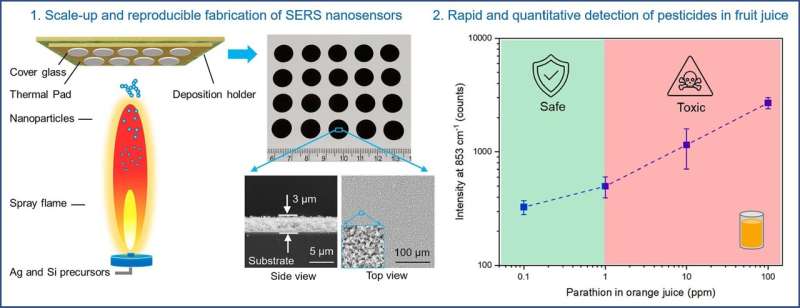
Karolinska Institutet researchers Georgios Sotiriou and Haipeng Li at the Department of Microbiology, Tumor and Cell Biology have developed an inexpensive, fast, and reproducible nanosensor for food safety diagnostics. A new study in the Chemical Engineering Journal shows that the sensors can detect pesticides in fresh orange juice.
The study uses flame nanoparticle deposition to drastically lower manufacturing costs. These high-performance optical sensors can be fabricated at a laboratory production rate of 100 samples/hour, demonstrating the scalability and cost-effectiveness of the aerosol manufacturing strategy democratizing these sensors for practical applications.
“The abuse of pesticides in modern agriculture causes food safety and human health concerns, which are highlighted by the World Health Organization. As a result, to avoid any risks to human health, it is necessary to control the pesticide residue levels in food below safety limits.
“While SERS is powerful for fast and facile detection of pesticide residues in food products, its practical application is still restricted by the high expense, low scalability, and low reproducibility of the necessary sensors. To address this challenge, we explored here a low-cost, massive, and highly reproducible nanofabrication route for manufacturing SERS nano-plasmonic optical sensors,” Georgios Sotiriou says.
“We used a process famous for its scalability and reproducibility, flame aerosol technology, to design and develop our robust nano-plasmonic optical sensors. We studied the surface uniformity, limit of detection, long-term stability, spot-to-spot reproducibility, sample-to-sample reproducibility, and batch-to-batch reproducibility of the fabricated SERS sensors.
“In addition, we benchmarked the performance of our SERS sensors against several state-of-the-art commercially available products and demonstrated their feasibility in a realistic and practical application by detecting pesticide residues in fruit juices,” says Haipeng Li.
The team is now planning to increase the scalability of the fabrication process, aiming to offer affordable sensors for the market.
“We will also expand the application of our nano-sensors from detecting single pesticides to the mixed pesticides, i.e., to detect the ‘cocktail effect of pesticides’ (a combination of multiple chemicals may become more toxic) that are urgent for food safety in the EU. We are open to worldwide collaborations, which will speed up the integration of scientific work from the laboratory to society,” Georgios Sotiriou says.
More information:
Haipeng Li et al, Democratizing robust SERS nano-sensors for food safety diagnostics, Chemical Engineering Journal (2023). DOI: 10.1016/j.cej.2023.144023
Provided by
Karolinska Institutet

READ MORE
Ridiculous History: The Time We Erased One of the World’s Biggest Waterfalls
Guair Falls, pictured here in December 1978, was submerged after the construction of Itaipu Dam. [...]
Towards straintronics: Guiding excitons in 2D materials
Topography of the two-dimensional crystal on top of the microscopically small wire indicated by dashed [...]
A single fiber actuator inspired by human muscles
Assembled 100-strands of artificial muscle fiber bundle structure on a slide glass. Credit: Kim et [...]
Humans Have Promoted the Reef Shark to Apex Predator
Sharks are a broad and diverse group of species, but in the public imagination we [...]
Researchers develop new technology to measure rotational motion of cells
Graphical abstract. Credit: Nano Letters (2022). DOI: 10.1021/acs.nanolett.2c02232 Mechanics plays a fundamental role in cell [...]
These Bold Illustrations Celebrate the Incredible Contributions of Women in Science
/ Mae Jemison, “The first black woman in space.” The astronaut is also an engineer [...]
How Chaos Theory Works
Computing how quantum states overlap
The floating block method pictured as ice blocks and the sea. The method applies a [...]